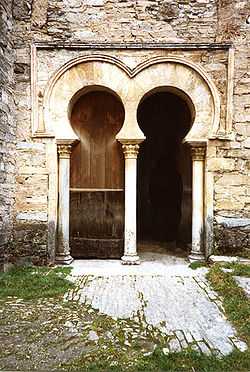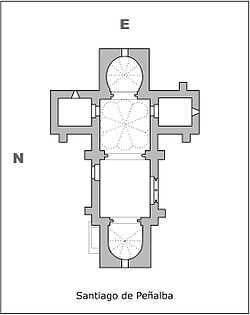Santiago de Peñalba


The church of Santiago de Peñalba is a Mozarabic building in the Valle del Silencio (Silence Valley) in the region of El Bierzo, close to Ponferrada, province of León, Community of Castile and León, Spain.
The Valle del Silencio area was full of sanctuaries and monasteries since the 8th century, and was called "La Tebaida Berciana" (Bercian Thebaid).
History
Abbot Salomón promoted its construction in the first one-half of the 10th century, in times of complete prosperity of the Kingdom of León. It was concretely under Ramiro II reign, who expanded the limits of the kingdom beyond the Duero River. Ramiro II made multiple donations to the church and the monastery of the locality.
One of those donations made to the Bishopric of Astorga was the so-called Cruz de Peñalba (Cross of Peñalba), symbol of El Bierzo's comarca. This cross is an example of Visigothic goldsmithery influence on the mozarabic models.
Architecture
The church is characterized by opposed apses, an unusual feature shared with the tenth-century church of San Cebrián de Mazote (also constructed during Kingdom of León apogee).
Its decoration is a mixture of Celtic elements (lunar and astral symbols), Byzantine (its Greek-cross plant), Arab (a little umbrella roof dome covers the principal altar) and Mozarabic (horseshoe arches).
| Wikimedia Commons has media related to Santiago de Peñalba. |
External links
Coordinates: 42°25′38″N 6°32′27″W / 42.4272°N 6.54083°W